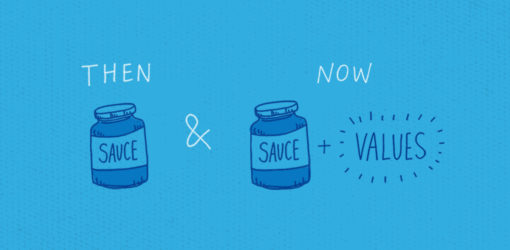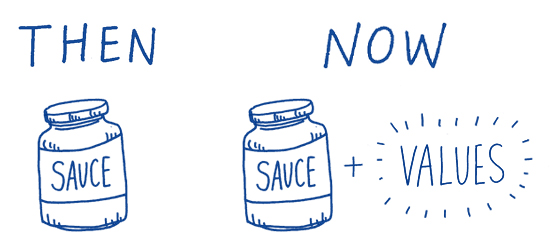
The perfect ad—you’ve seen it before. A group of friends or a family; one brown, one yellow, one white. A utopian mix of races, genders, even lifestyles.
For decades, brands have approached diversity (and inclusion) in this way, and it makes sense.
In fact, a 2016 study found that 80% of millennial parents enjoy seeing diverse families in advertising. 66% said that when deciding on a product, they are more likely to consider brands that demonstrate a reverence for all kinds of families, and 49% of millennial parents have a greater tendency to discuss these brands with their friends, 41% of them choosing to purchase these products.
I, myself, as a mixed-race person, appreciate when I see people that look like me in ads.
Sort of.
I’m a third-generation Japanese, Chinese, Portuguese and German 30-something year-old who grew up in Hawaii. Because I’m a quarter of each, I don’t fully identify with one race, though I’m often labeled an “Asian.” Too frequently do I feel like the nuance of my identity is either oversimplified or overlooked.
Companies are often guilty of this same oversimplification, mimicking diversity in their advertisements and commercials through a one-dimensional interpretation that reduces diversity to skin color. I also never find myself in a group of a friends that perfectly includes every cross-section of society. Do you?
My experience has taught me two important lessons about diversity that brands struggle to navigate.
Diversity is complicated.
For a while, “diversity” was what we aspired toward. You might say we were trying to get from point A (no diversity) to point B (diversity). But what we need now is better diversity. We need to start thinking about point C, and it’s no longer going to be as simple as adding different faces to the mix.
Recently, a friend of mine shared this Prego commercial on Facebook:
He raved about Prego and how he couldn’t believe that Filipino spaghetti was featured in a mainstream ad campaign. Within minutes, people were commenting on his post, sharing how thrilled they were to see a Filipino American family and to hear Tagalog (the language of the Phillipines) in a national spot—a spot that tastefully and authentically delivered the message—The love shared over family dinner never gets lost in translation.
This made me think about what a Prego commercial looked like 30 years ago:
Back then, Prego focused on marketing their sauce, not necessarily their values. However, today’s consumers expect more than just the same sauce.
By repositioning their nearly 40-year old product and reflecting the changing idea of what an American family looks like, Prego is capturing the attention of a new (and diverse) generation of consumers.
Diversity doesn’t equal inclusion.
Returning our focus to the “perfect ad,” we wonder why companies choose to approach diversity in this way.
As it turns out, businesses have become obsessed with proving their brand’s inclusivity. They are eager to share their “open-mindedness” through their advertising in order to stay relevant and capture the hearts (and wallets) of a new generation of consumers. Unfortunately, that is usually where it stops.
However, a brand is simply an extension of a company’s values—what they do and who they are. If the company doesn’t believe in something, its brand can’t pretend to.
It’s therefore not enough for a brand to say it values diversity—it has to actually practice inclusivity, and allow the effect of inclusion to saturate its practice and products.
Companies are learning this, and are beginning to catch on.
Nike, for example, has shown many diverse faces in its ads for years. But in 2017, it released its first ever hijab—the Nike Pro Hijab—designed for female Muslim athletes. It was applauded as the most important design of 2017 by Co.Design who sang, “by creating the Pro Hijab, Nike sends an important message about inclusion and encourages a generation of Muslim girls to think of themselves as athletes.”

Nike went beyond simply showing different skin colors in its ads, and actually implemented its inclusive behavior by creating a product that not only proved Nike’s inclusivity, but made a bold and unprecedented statement that redefined the modern athlete.
Microsoft has similarly breached boundaries and pushed into inclusive design. The company believes that learning from different people and methods allows them to develop better products, bridge gaps, and create connections between cultures, classes, and generations. There’s no doubt that Microsoft wants to be perceived as a company that values diversity and practices inclusion. However, it is also striving to help other companies and people create better inclusion. Its branded experience, for example, contains an “Inclusive Design Toolkit” and other free resources that promote inclusivity as a driver for innovation.

This approach to diversity reflects more than Microsoft’s ability to change perception; it reflects the kind of world it hopes to create, and its plans to help create it.
This all demonstrates the real-life stride towards Point C—the commitment to not only creating the perception of diversity, but the actual inclusivity it fosters.
But challenging the status quo isn’t always easy. It takes constant work, and a commitment to the cause. Efforts to disrupt the norm sometimes result in initial resistance. Nike’s Pro Hijab, for example, while lauded as industry-changing also endured some criticism propagating the hashtag #boycottNike. Cheerios also experienced some negative attention after it featured an interracial family in its commercials.
Getting to Point C is going to be a challenge. In addition to figuring out what better diversity entails, we also have to acknowledge that diversity and inclusion—like society—is evolving; So much so that by 2055, a racial or ethnic majority will not even exist in the United States.
As people change, so will their expectations. For brands, this presents a major opportunity to promote true inclusivity that allows them to grow not only alongside their consumers but also their bottom lines.


 Lessons in Daring
Lessons in Daring  Talk to Me: Reading Out Loud as Part of the Writing Process
Talk to Me: Reading Out Loud as Part of the Writing Process  Getting the Most Out of Conferences
Getting the Most Out of Conferences
#MOVINGtoPOINTc!